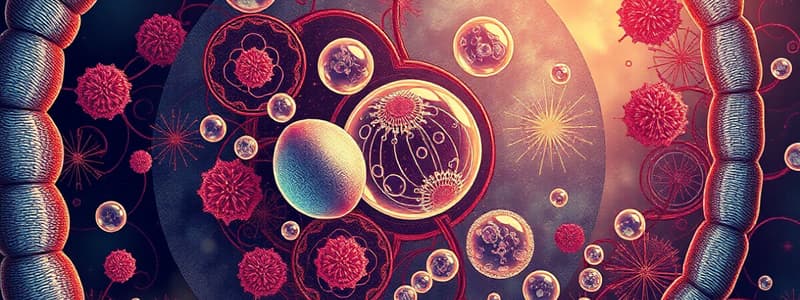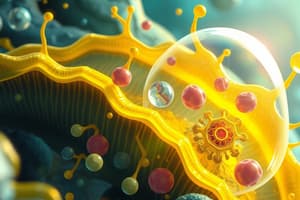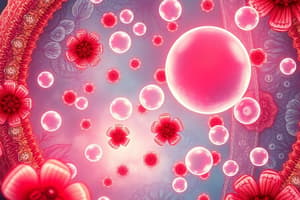Podcast
Questions and Answers
DNA replication is the process of creating an identical copy of a ______ molecule.
DNA replication is the process of creating an identical copy of a ______ molecule.
DNA
Transcription is the process of copying a gene's ______ sequence into RNA.
Transcription is the process of copying a gene's ______ sequence into RNA.
DNA
Gregor Mendel's experiments established the basic principles of ______.
Gregor Mendel's experiments established the basic principles of ______.
heredity
Phenotype refers to observable ______.
Phenotype refers to observable ______.
Ecology deals with the interactions of organisms with each other and their ______.
Ecology deals with the interactions of organisms with each other and their ______.
Natural selection is a key mechanism driving ______.
Natural selection is a key mechanism driving ______.
Enzymes are biological ______ that accelerate metabolic reactions.
Enzymes are biological ______ that accelerate metabolic reactions.
Ecosystems comprise communities of organisms and their physical ______.
Ecosystems comprise communities of organisms and their physical ______.
The cell membrane is a selectively permeable barrier that regulates the passage of substances into and out of the ______.
The cell membrane is a selectively permeable barrier that regulates the passage of substances into and out of the ______.
Mitochondria are known as the ______ of the cell, producing energy.
Mitochondria are known as the ______ of the cell, producing energy.
Photosynthesis takes place in ______, specifically in the thylakoid membranes.
Photosynthesis takes place in ______, specifically in the thylakoid membranes.
The three domains of life are Bacteria, Archaea, and ______.
The three domains of life are Bacteria, Archaea, and ______.
The Krebs cycle occurs in the ______ matrix.
The Krebs cycle occurs in the ______ matrix.
In cellular respiration, glycolysis is an ______ process occurring in the cytoplasm.
In cellular respiration, glycolysis is an ______ process occurring in the cytoplasm.
Binomial nomenclature is the ______-part naming system used to scientifically name organisms.
Binomial nomenclature is the ______-part naming system used to scientifically name organisms.
The light-independent reactions of photosynthesis are also known as the ______ cycle.
The light-independent reactions of photosynthesis are also known as the ______ cycle.
Flashcards
DNA Replication
DNA Replication
The process of creating an identical copy of a DNA molecule. It ensures genetic continuity during cell division.
Protein Synthesis
Protein Synthesis
The process of using a DNA sequence to build a specific protein. It involves two steps: transcription and translation.
Alleles
Alleles
Different forms of a gene. For example, a gene for eye color could have alleles for blue, brown, or green eyes.
Phenotype
Phenotype
Signup and view all the flashcards
Genotype
Genotype
Signup and view all the flashcards
Adaptation
Adaptation
Signup and view all the flashcards
Enzymes
Enzymes
Signup and view all the flashcards
Metabolic Pathways
Metabolic Pathways
Signup and view all the flashcards
What are cells?
What are cells?
Signup and view all the flashcards
What is the cell membrane?
What is the cell membrane?
Signup and view all the flashcards
What is the cytoplasm?
What is the cytoplasm?
Signup and view all the flashcards
What are mitochondria?
What are mitochondria?
Signup and view all the flashcards
What is cellular respiration?
What is cellular respiration?
Signup and view all the flashcards
What is photosynthesis?
What is photosynthesis?
Signup and view all the flashcards
What is chlorophyll?
What is chlorophyll?
Signup and view all the flashcards
What is binomial nomenclature?
What is binomial nomenclature?
Signup and view all the flashcards
Signup and view all the flashcards
Signup and view all the flashcards
Study Notes
Cell Structure and Function
- Cells are the basic units of life, exhibiting a wide range of shapes and sizes.
- Cells are composed of various organelles, each with specific functions.
- The cell membrane is a selectively permeable barrier, controlling substance movement in and out of the cell.
- The cytoplasm is the jelly-like substance filling the cell, containing organelles.
- Nucleus contains the cell's genetic material (DNA).
- Ribosomes are responsible for protein synthesis.
- Mitochondria are the powerhouses of the cell, producing energy.
- Endoplasmic reticulum (ER) is involved in protein and lipid synthesis.
- Golgi apparatus processes and packages proteins.
- Lysosomes contain enzymes for cellular waste digestion.
- Vacuoles store water and other substances.
- Cytoskeleton provides structural support and enables cell movement.
- Plant cells possess a cell wall, chloroplasts for photosynthesis, and a large central vacuole, which differentiate them from animal cells.
Classification of Living Organisms
- Organisms are grouped into hierarchical categories, from domain to species.
- The three domains are Bacteria, Archaea, and Eukarya.
- Eukarya includes protists, fungi, plants, and animals.
- Organisms are classified based on shared characteristics, evolutionary relationships, and genetic similarities.
- Binomial nomenclature (two-part naming system) is used to scientifically name organisms.
Cellular Respiration
- Cellular respiration is the process cells use to break down glucose and release energy.
- The process occurs in several stages, including glycolysis, the Krebs cycle, and oxidative phosphorylation.
- Glycolysis is an anaerobic process occurring in the cytoplasm.
- The Krebs cycle occurs in the mitochondrial matrix.
- Oxidative phosphorylation occurs in the inner mitochondrial membrane.
- Cellular respiration produces ATP, the cell's primary energy currency.
- The process requires oxygen (aerobic).
Photosynthesis
- Photosynthesis is the process by which plants and some other organisms convert light energy into chemical energy.
- The process involves capturing light energy using chlorophyll and converting it into usable energy.
- Photosynthesis takes place in chloroplasts, specifically in the thylakoid membranes.
- Photosynthesis produces glucose and oxygen.
- Light-dependent reactions capture light energy.
- Light-independent (Calvin cycle) reactions use this energy to convert carbon dioxide into glucose.
DNA Replication and Protein Synthesis
- DNA replication creates an identical copy of a DNA molecule.
- This ensures genetic continuity during cell division.
- DNA replication involves unwinding the double helix, separating strands, and synthesizing new complementary strands.
- Protein synthesis involves transcription and translation.
- Transcription copies a gene's DNA sequence into RNA.
- Translation uses the RNA sequence to build a protein.
- Mutations during replication can affect protein structure and function.
Mendelian Genetics
- Gregor Mendel's experiments established the basic principles of heredity.
- Traits are determined by genes, located on chromosomes.
- Alleles are different forms of a gene.
- Dominant alleles mask recessive alleles.
- Phenotype refers to observable characteristics.
- Genotype refers to the genetic makeup.
- Punnett squares predict offspring trait probabilities.
Ecology
- Ecology studies organism interactions with each other and their environment.
- Levels of organization range from individuals to ecosystems.
- Biotic factors are living organisms, while abiotic factors are non-living components (climate, soil).
- Ecosystems encompass communities and their physical environment.
- Food chains and food webs show energy flow.
- Ecological succession describes gradual species changes.
- Population dynamics affect population size and distribution.
Evolution
- Evolution describes gradual species changes over long periods.
- Natural selection is a key driver of evolution.
- Adaptation is the process of evolving traits for survival and reproduction in a specific environment.
- Evidence for evolution includes fossil records, comparative anatomy, molecular biology, and biogeography.
Biochemistry
- Biochemistry studies the chemical processes in living organisms.
- Organic molecules (carbohydrates, lipids, proteins, nucleic acids) are essential components of life.
- Enzymes are biological catalysts accelerating metabolic reactions.
- Metabolic pathways are interconnected sequences of biochemical reactions.
Studying That Suits You
Use AI to generate personalized quizzes and flashcards to suit your learning preferences.




